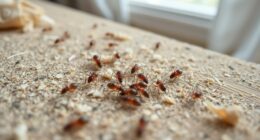To prevent burrowing rodents from accessing your home, identify their entry points and install durable barriers like galvanized metal or concrete, buried at least 12 inches underground and extended beyond their tunnels. Seal all cracks around pipes, vents, and foundations with steel wool or mesh, and reinforce weak spots. Regular inspections and repairs guarantee ongoing effectiveness. For detailed tips on installation and maintenance that create a solid defense, keep exploring these essential strategies.
Key Takeaways
- Use durable, rodent-proof materials like galvanized metal or concrete to seal potential entry points effectively.
- Bury barriers at least 12 inches underground with a trench of 6-12 inches to prevent tunneling.
- Seal all cracks around pipes, vents, and utility lines using steel wool or metal mesh.
- Regularly inspect and repair any damage or gaps in existing barriers or home structures.
- Combine physical barriers with yard maintenance and natural deterrents for comprehensive protection.
Understanding Burrowing Rodent Behavior and Habitats
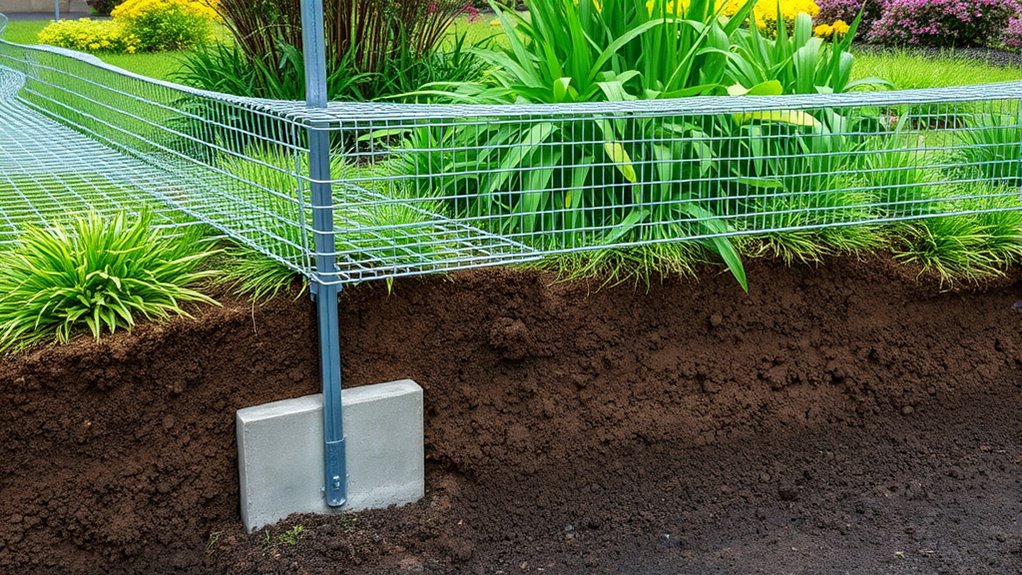
Understanding burrowing rodent behavior and habitats is essential for effective physical barrier strategies. You need to recognize that these rodents often create complex rodent nesting sites, which can include multiple entrances and tunnels. Their burrow excavation can occur just below the surface or extend deep underground, making detection challenging. Rodents prefer areas with loose soil, debris, and access to food sources. By observing signs like fresh soil mounds or gnawed vegetation, you can identify active burrows. Knowing their habits helps you place barriers more strategically, targeting entry points and preventing them from expanding their burrow systems. Additionally, understanding how and where these rodents dig allows you to develop more effective, targeted measures to keep them out of your property by identifying their preferred habitats.
Selecting the Right Materials for Barriers
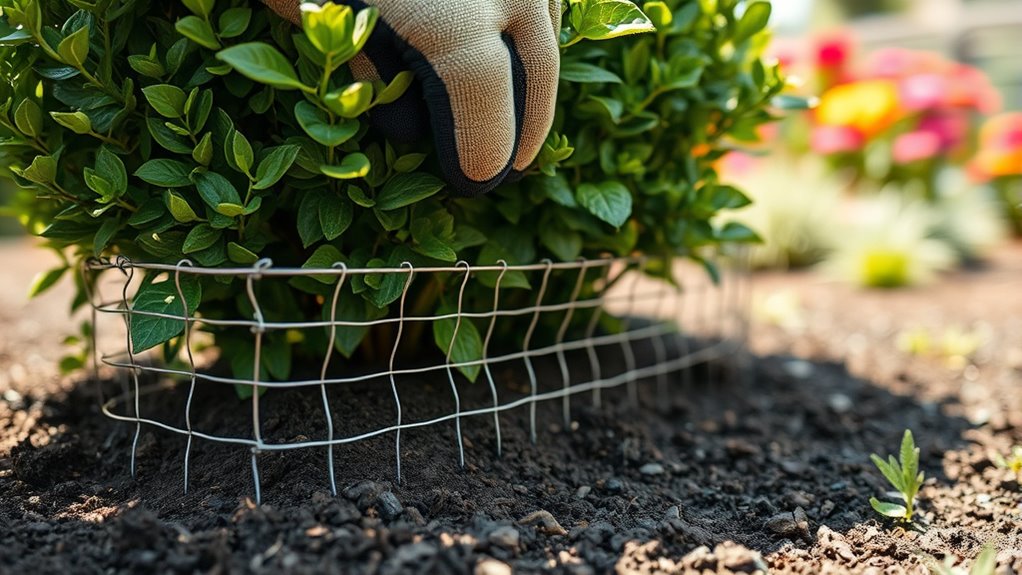
Choosing the right materials for barriers is crucial in effectively preventing rodent entry. You need durable options that withstand weather and soil conditions, guaranteeing long-lasting protection. Consider aesthetic factors to ensure the barrier blends with your landscape without sacrificing function. For ideal results, look for materials that offer:
Choosing durable, weather-resistant materials like galvanized metal ensures effective, long-lasting rodent barriers that blend seamlessly with your landscape.
- High material durability to resist gnawing and environmental wear
- Compatibility with soil and underground installation
- Low maintenance requirements
- Aesthetic appeal to match your property’s design
Materials like galvanized metal or hardware cloth excel because they’re tough and discreet. Avoid flimsy or easily chewed options, as they won’t provide reliable protection. Selecting the right combination of durability and aesthetics ensures your barrier remains effective and visually unobtrusive over time. Additionally, understanding cultural impact on design choices can help you select materials that complement your overall landscape aesthetic.
Designing Effective Physical Barriers
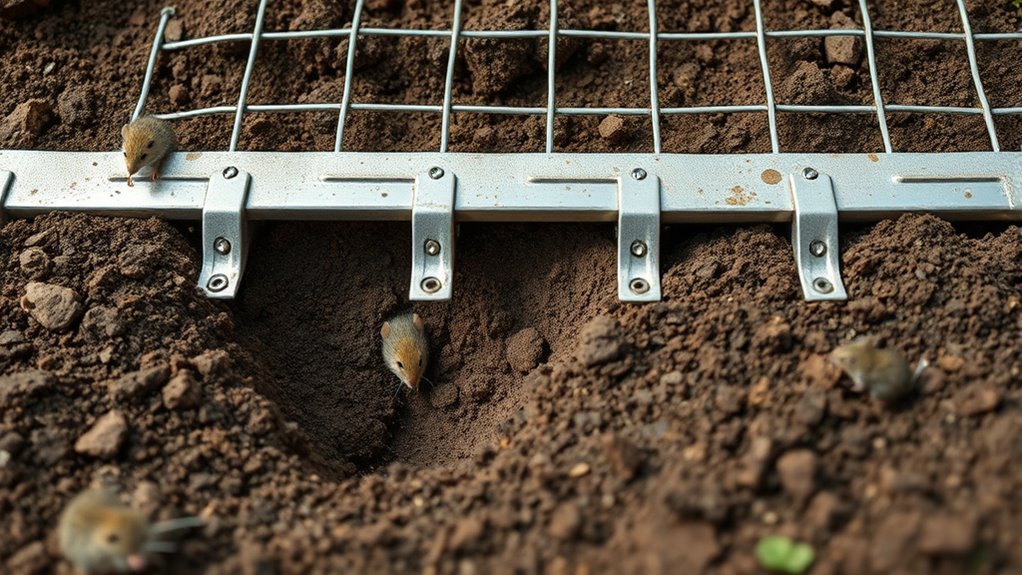
To guarantee your physical barriers effectively keep rodents out, it’s essential to design them with precise specifications and strategic placement. Use durable, rodent-proof materials like metal or concrete, ensuring no gaps or holes. Incorporate wireless deterrents around the barrier’s perimeter to provide an extra layer of protection; these devices emit sounds or vibrations that discourage rodents from approaching. Chemical repellents can be applied at key points to deter burrowing near the barrier, enhancing its effectiveness. When designing, consider the barrier’s depth—bury it at least 12 inches underground and extend it outward to prevent rodents from tunneling underneath. Proper placement and integration of deterrents and repellents help create a thorough physical barrier system. Additionally, understanding Cost and Budgeting can help plan for ongoing maintenance and potential upgrades to your rodent barriers.
Installing Barriers Properly for Maximum Effectiveness
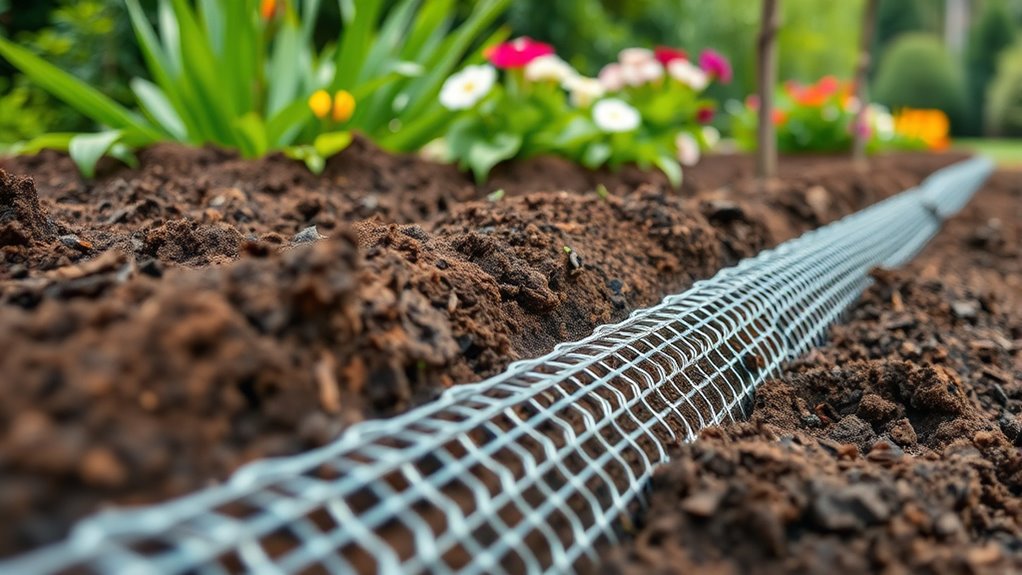
To guarantee your barriers keep rodents out, you need to install them correctly. Bury the edges deep into the ground to prevent creatures from digging underneath, and choose fine mesh material to block even small pests. Proper installation makes all the difference in creating an effective, long-lasting defense. Ensuring your barrier meets precious metals investment standards can also enhance its durability and security.
Bury Barrier Edges Deep
Burying the edges of your rodent barrier deep into the ground is essential for preventing pests from digging underneath. Proper deep trenching guarantees rodents can’t tunnel beneath the barrier, maintaining its integrity. Aim for a barrier height that discourages jumping or climbing, and dig a trench at least 6-12 inches deep. Bend the barrier outward at the trench’s bottom to create a secure seal against burrowing pests. Seal all seams tightly to prevent gaps. Consider these key tips:
- Use deep trenching to extend the barrier below the surface
- Ensure barrier edges are buried at least 6-12 inches deep
- Fold the barrier outward to block tunneling
- Maintain a consistent barrier height for maximum effectiveness
Deep trenching combined with proper installation makes it difficult for rodents to bypass your defenses. Additionally, using proper materials designed specifically for rodent barriers can enhance durability and effectiveness.
Use Fine Mesh Material
Using fine mesh material is vital for creating an effective rodent barrier because it prevents pests from squeezing through small openings. When installing the mesh, make sure it covers potential entry points completely, including vents and foundation cracks. Proper trap placement is essential—position traps near active burrows or signs of rodent activity behind the mesh. Incorporate bait stations along the barrier to lure rodents away from vulnerable areas and increase your chances of capture. Secure the mesh tightly to the ground and any structures, leaving no gaps for rodents to exploit. Regularly inspect the mesh for tears or displacement, especially after weather events. Additionally, understanding Fokos can provide insights into effective pest control strategies. By combining fine mesh with strategic trap placement and bait stations, you maximize your barrier’s effectiveness and reduce rodent intrusion.
Maintaining and Inspecting Barriers Over Time
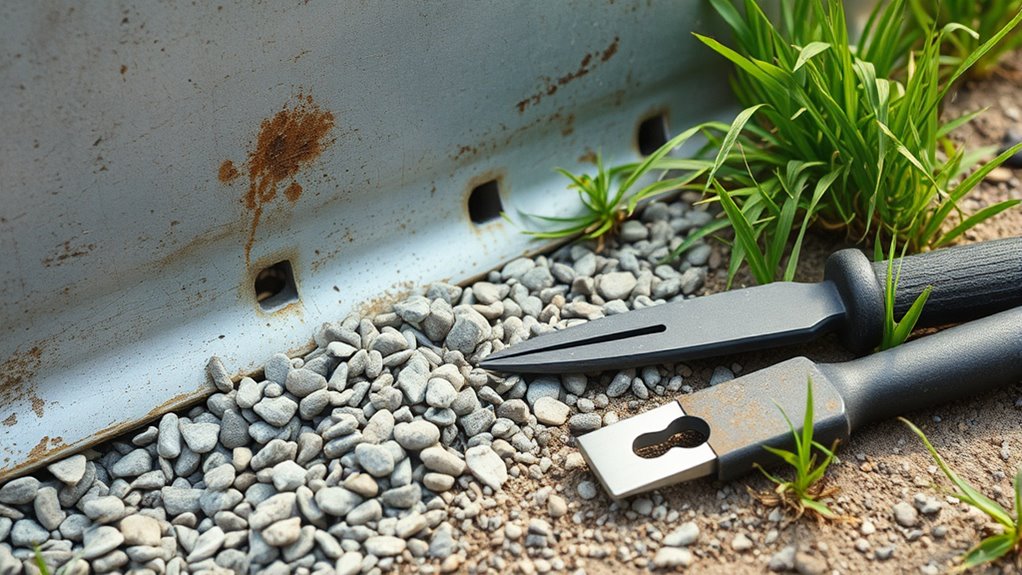
Regularly inspecting and maintaining your barriers is essential to guarantee they remain effective against rodents. Over time, wear and damage can compromise their integrity, making regular checks crucial. Conduct seasonal inspections to catch issues early, especially after severe weather or shifts in the ground. When you find damage, implement repair strategies promptly to prevent rodent entry. Keep an eye out for:
- Gaps or holes in mesh or fencing
- Shifting or sinking barriers
- Rust or corrosion weakening materials
- Signs of burrowing near the barrier
Addressing small issues quickly helps maintain a continuous defense. Routine maintenance ensures your barriers stay sturdy and functional, providing long-term protection against burrowing rodents. Staying vigilant saves you time and effort in the future. Additionally, understanding best practices for barrier maintenance can help prolong their effectiveness and prevent costly repairs later on.
Additional Tips for Preventing Rodent Intrusions
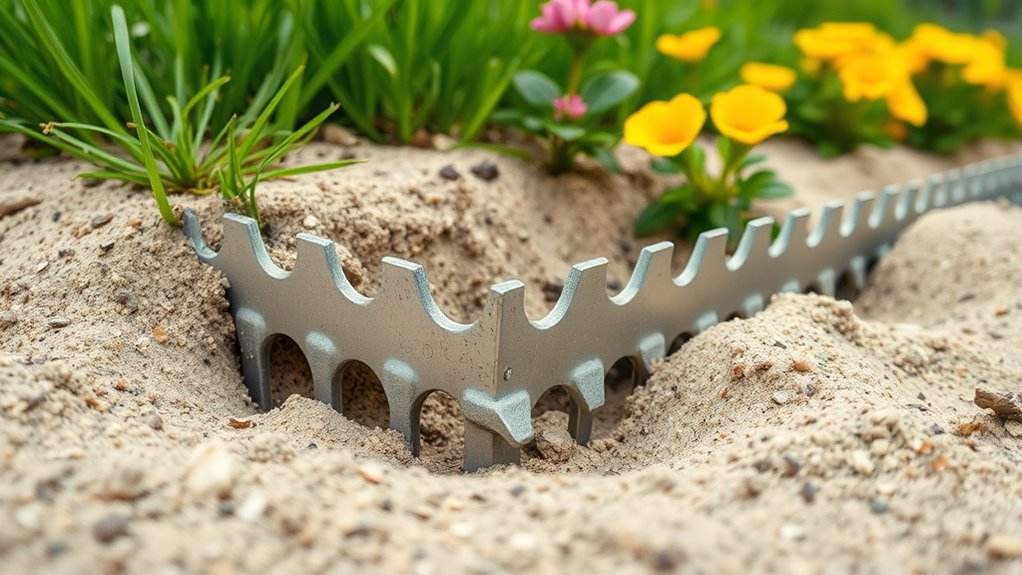
To keep rodents out, start by sealing all entry points in your home. Keep your yard tidy and free of debris to eliminate hiding spots. You can also use natural repellents around your property to discourage intrusions. Additionally, implementing size restrictions can help prevent rodents from gaining access to your property in the first place.
Seal Entry Points
Sealing entry points is one of the most effective ways to prevent rodents from invading your space. Rodents can squeeze through tiny gaps, gnawing hazards, and find nesting sites inside walls, attics, or basements. To block their access, inspect your home thoroughly, focusing on potential openings.
- Seal cracks around pipes, vents, and utility lines
- Use steel wool or metal mesh to close small holes
- Install door sweeps on exterior doors
- Repair damaged window screens and vents
- Ensuring proper projector setup can help identify hidden entry points or vulnerabilities in your home’s structure.
Maintain Yard Cleanliness
Keeping your yard tidy is essential in preventing rodents from establishing a presence near your home. Garden pests like rodents are attracted to clutter, debris, and overgrown plants that provide hiding spots and easy access to food sources. Regularly remove fallen leaves, discarded trash, and unused tools to eliminate these attractants. Use effective landscaping techniques, such as trimming dense shrubbery and maintaining a clear perimeter, to reduce shelter options for pests. Keep compost bins sealed tightly and store firewood and pet food off the ground. Maintaining landscape management practices can further deter rodents by reducing potential nesting sites. A neat yard not only discourages rodents but also makes it easier to spot signs of intrusion early. By maintaining cleanliness and applying smart landscaping practices, you create a hostile environment for burrowing rodents, reducing their chances of invading your space.
Use Natural Repellents
Wondering how to naturally deter rodents from your yard? Natural repellents are a safe, eco-friendly way to keep these pests away without relying on chemical deterrents. You can try planting strong-scented herbs like mint, sage, or rosemary around your garden, as rodents dislike their smell. Using dried capsaicin or chili powder sprinkled near entry points can also act as a natural barrier. Additionally, spreading predator urine around your property mimics natural predators and discourages burrowing. Finally, essential oils such as peppermint or eucalyptus soaked in cotton balls can be placed in problem areas to repel rodents. These natural repellents are effective alternatives to chemical deterrents, helping you maintain a rodent-free yard while avoiding harmful chemicals.
Frequently Asked Questions
How Long Do Physical Barriers Typically Last Before Needing Replacement?
You wonder how long physical barriers last before replacement. Typically, material longevity depends on the type of material used and environmental factors, but most barriers need replacement every 3 to 5 years. Regular maintenance frequency is essential to check for damage or wear, especially after storms or harsh weather. By inspecting your barriers regularly and promptly repairing any issues, you can extend their effectiveness and protect your property longer.
Can Barriers Be Installed DIY or Should Professionals Be Hired?
When deciding whether to do DIY installation or hire professional services, consider your skill level and the barrier’s complexity. DIY installation can save money and be straightforward for simple projects, but professional services guarantee proper placement and durability, especially for larger or more challenging setups. If you’re confident and have the right tools, go ahead with DIY; otherwise, hiring experts ensures the job’s done correctly and effectively.
Are There Environmentally Friendly Options for Rodent Barriers?
When considering creating physical barriers against burrowing rodents, eco-friendly options offer effective, environmentally conscious choices. You can opt for biodegradable options like natural wire mesh or recycled materials that resist rodents while respecting nature. These environmentally friendly materials promote sustainable solutions, reducing environmental impact. By choosing eco-conscious options, you guarantee your rodent barriers are both effective and earth-friendly, helping protect your property and the planet simultaneously.
What Are the Signs That Rodents Have Breached a Barrier?
You should look for signs of breach around your property, such as new holes or gnaw marks near suspected rodent entry points. Keep an eye out for shredded insulation, droppings, or greasy smudges along walls and foundations. These signs indicate rodents have found ways past your barriers. Regular inspections help identify breaches early, allowing you to seal entry points promptly and prevent further intrusion.
How Do Barriers Affect Other Wildlife in the Area?
Wildlife worsens with barriers, causing unintended wildlife disruption and habitat alteration. You might notice that barriers block beneficial animals, restricting their movement and access to resources. This can disturb natural dynamics, reduce biodiversity, and lead to habitat homogenization. While aiming to deter pests, you inadvertently impact other wildlife, potentially creating a cascade of ecological consequences. Being mindful of these effects helps you balance pest control with protecting the area’s delicate ecological equilibrium.
Conclusion
By understanding rodent habits and choosing the right materials, you create a fortress that keeps pests at bay. Proper installation and regular inspections are like tending a garden—you guarantee your defenses stay strong and effective. Think of your barrier as a shield, standing firm against unwanted intruders. With consistent maintenance, you’ll turn your yard into a safe haven, where rodents can’t burrow their way in, allowing your peace of mind to flourish like a well-tended tree.







